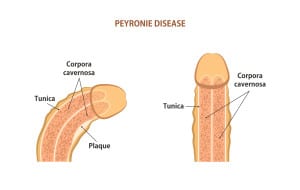Peyronie’s Disease Treatment
in Chattanooga, TN
Correct Damage Caused by Peyronie’s Disease

Learn About Peyronie’s Disease Treatment Options in Chattanooga Here
Peyronie’s Disease Causes
- Aging
- Hormonal/Low Testosterone
- Diabetes Mellitus
- Prostatectomy for prostate cancer
- Penile Trauma/Fracture
- ED
- Dupuytren’s Disease
- Congenital Penile Curvature
WHAT ARE THE SYMPTOMS OF PEYRONIE’S DISEASE?
Peyronie’s Disease doesn’t follow a singular progression: it can develop suddenly or gradually. These are the common signs and symptoms:
- Scar tissue — The scar tissue associated with Peyronie’s Disease can be felt under the skin of the penis as flat lumps or a band of hard tissue.
- A significant bend to the penis — The penis may curve upward or downward or lean to one side.
- Erectile dysfunction — Peyronie’s can cause problems attaining and maintaining an erection, but this problem is often reported prior to the patient seeing symptoms of the disease.
- Shortening of the penis — Peyronie’s Disease can make the penis shorter.
- Pain — Patients can have pain, with or without an erection.
- Other penile deformities — In some men with Peyronie’s Disease, the erect penis might have narrowing, indentation, or even an hourglass-like appearance, with a tight, narrow band around the shaft.
HOW PEYRONIE’S DISEASE CAUSES PENILE DEFORMITY
- There are two erectile cylinders within every penis that sit above the urethra, the tube through which you urinate.
- The erectile tubes have a strong elastic covering called the tunica albuginea. The tunica can rip or tear during sexual intercourse.
- In most men, it heals normally. But, in men with PD, an abnormal inelastic scar forms, called a plaque.
- The plaque, or lump on the penis, is usually the first sign of PD disease.
- Since the plaque is inelastic, meaning it stretches poorly, a noticeable deformity in the penis appears when the penis is erect.
- The penis can bend up, down, left, right, or have a combination of different bends.
- Sometimes the plaque can narrow the penis causing decreased girth and loss of length, which can be significant.
- The plaque usually causes some inflammation or irritation of the penile nerves which can result in painful erections.
CAN PD AFFECT MY ERECTIONS?
Yes. Because the Peyronie’s plaque is inelastic it cannot trap the blood within the erectile cylinders as well as normal elastic tissue can. Veins that travel through the tunica are usually compressed during normal erection but are not in the Peyronie’s plaque. About 1/3 of men with PD will develop ED during the course of their disease process. This can be treated with the same medications and procedures that are used to treat ED from other causes.
WHY IS IT IMPORTANT TO SEEK UROLOGIC CONSULTATION? FOR PD

Meet Our Urologist, Dr. Shridharani Here
See What Our Patients Are Saying!
(Google Review)
“Dr. Anand was absolutely great. He explained in layman’s terms what my condition was and what course of action that we would be taking for my health. He was very kind to me and treated me with dignity and respect.” – E.N.
HOW IS PEYRONIE’S DISEASE EVALUATED?
An assessment of the man’s health, medical conditions, medications, and lifestyle will be performed. The impact of PD on the individual and couple will also be assessed via questionnaire. A focused physical examination is mandatory. Imaging tests may be used to check for structural abnormalities and blood flow in most cases to fully assess the disease. The results of these tests will help your doctor determine the best treatment options.
Dr. Shridharani recommends that individuals bring their partner to the consultation if one exists and the man is comfortable doing so. He believes this will appropriately address all issues affecting the man and partner as well as involving them both in the care plan.
WHAT IS THE NEXT STEP?
Millions of men suffer from PD. Many of these men will not discuss these issues with their care providers out of embarrassment, a sense of helplessness, or fear of unknown treatments. PD is an undeniably treatable condition. Dr. Shridharani has advanced urological training in the management of PD, and his clinic is devoted to Men’s Health. We provide a comfortable setting where your quality of life issues will be managed at your pace. Our mission is to help you regain full sexual function and intimacy with your loved one.
Schedule a Consultation Today
HOW PEYRONIE’S DISEASE IS TREATED
Early Peyronie’s is classified as “acute.” This is when you may have penile pain or changes in curvature. This can last from just two to four weeks all the way up to a year or more. The “chronic” phase is when symptoms have stabilized. Any changes in curvature or length have settled. Treatment options Dr. Shridharani uses can vary depending upon if you have acute or chronic Peyronie’s Disease.
There are three different avenues Dr. Shridharani may use: medications, traction therapy, and surgery.
- Medications — Oral medications have been tried but have not shown to be consistently effective. In some men, drugs injected directly into the penis can reduce curvature and pain. Collagenase is the only FDA-approved drug for these direct injections. The FDA has approved it for adult men with moderate to severe curvatures and a palpable nodule. The drug works by breaking down the buildup of collagen that causes penile curvature.
- Traction therapy — Here a mechanical device is placed on the penis and worn for a set amount of time each day. The device may stretch the penis straight out, or it may stretch the penis in the opposite direction of the curve. Traction seems to work best in the early “acute” phase of Peyronie’s Disease.
- Surgery — Dr. Shridharani may recommend surgery if your deformity is severe, is sufficiently bothersome to you, or prevents you from being able to have sex. This avenue of treatment isn’t recommended until you’ve had the condition for nine to 12 months and the curvature has been stabilized for three to six months.
These are surgical methods used:
- Suturing (plicating) the unaffected side — There are a variety of procedures Dr. Shridharani may use to suture the longer side of the penis, the side without the scar tissue. This will straighten the penis, but it can only usually be done with less severe curvatures.
- Incision or excision and grafting — For this surgery, Dr. Shridharani makes one or more cuts in the scar tissue, allowing the sheath to stretch out and the penis to straighten. He may remove some of the scar tissue. If necessary, a graft may be placed over any holes created. This type of surgery is for cases of more-severe curvature or deformity (such as indentations).
- Penile implants — Implants can be placed into the spongy tissue that fills with blood during an erection. These implants may be semirigid, and they would manually be bent down most of the time and bent upward for sexual intercourse. A different option is to implant a pump in the scrotum.
Schedule an Appointment Here
CAN PEYRONIE’S DISEASE BE PREVENTED?
Most of Peyronie’s Disease cases develop due to injury to the penis during intercourse. There are things you can do to prevent this. These sorts of injuries typically happen to men when their erection isn’t as rigid as in their younger days. While intercourse may still be possible with a semi-erect penis, this is when an injury can happen if the penis bends when thrusting. This can damage the elastic tissue inside the penis. As the penis heals, scar tissue forms inside around the erection chambers causing the curvature. Still, there are other cases where there have not been injuries, but the patient still develops Peyronie’s.
If you’re concerned about developing Peyronie’s, there are a few options to be cognizant of:
- Take ED medications — As men age, their erections become less and less rigid. This is due to a few issues, especially weakening in the circulatory system feeding the penis. If you notice your erections are not as strong or as dependable, get ED medication. This will keep your erections firmer and less likely to allow bending and injury.
- Use lubrication — As women age, their vaginal lubrication decreases. Using an over-the-counter lubricant lessens the chances of possible bending trying to gain entry without sufficient lubrication.
- Stay on top — When the woman is on top, there is more chance the penis may be bent.
- Straight in and out — Try and keep your angles so that your thrusting is straight in and out.
- Pay attention — If you’ve had a few too many drinks or are tired, you may have a marginal erection. This is more prone to bending and damage.
CAN PEYRONIE’S DISEASE GO AWAY ON ITS OWN?
In some men, for unknown reasons, both the curvature and the pain associated with Peyronie’s Disease improve without treatment. This is not typical, however.
IS PEYRONIE’S DISEASE GENETIC?
The precise reason a man develops Peyronie’s Disease is not pinpointed, but there are a number of factors involved. It is thought to result in most cases from repeated injury to the penis. This could happen during sex or athletic activity. But in some men, Peyronie’s seems to develop gradually and doesn’t seem related to an injury. In these men, it is thought the condition could be linked to an inherited trait. To that end, if a family member has Peyronie’s Disease you have an increased risk of developing it.
Schedule Your Chattanooga Peyronie’s Disease Appointment Today
Contact Dr. Shrid Men’s Health & Microsurgery today or if you are in the Knoxville, Tennessee, Huntsville, Alabama, or Northern Georgia area, visit us in Chattanooga, TN to learn more about Peyronie’s Disease.


